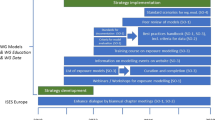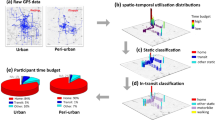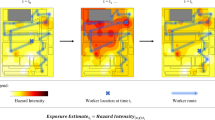Abstract
In Europe, several occupational exposure models have been developed and are recommended for regulatory exposure assessment. Only some information on the substance of interest (e.g., vapor pressure) and the workplace conditions (e.g., ventilation rate) is required in these models to predict an exposure value that will be later used to characterize the risk. However, it has been shown that models may differ in their predictions and that usually, one of the models best fits a given set of exposure conditions. Unfortunately, there are no clear rules on how to select the best model. In this study, we developed a new modeling approach that together uses the three most popular models, Advanced REACH Tool, Stoffenmanger, and ECETOC TRAv3, to obtain a unique exposure prediction. This approach is an extension of the TREXMO tool, and is called TREXMO+. TREXMO+ applies a machine-learning technique on a set of exposure data with the measured values to split them into smaller subsets, corresponding to exposure conditions sharing similar characteristics. For each subset, TREXMO+ then establishes a regression model with the three REACH tools used as the exposure predictors. The performance of the new model was tested and a comparison was made between the results obtained by TREXMO+ and those obtained by conventional tools. TREXMO+ model was found to be less biased and more accurate than the REACH models. Its prediction differs generally from measurements by a factor of 2–3 from measurements, whereas conventional models were found to differ by a factor 2–14. However, as the available test dataset is limited, its results will need to be confirmed by larger-scale tests.
This is a preview of subscription content, access via your institution
Access options
Subscribe to this journal
Receive 6 print issues and online access
$259.00 per year
only $43.17 per issue
Buy this article
- Purchase on Springer Link
- Instant access to full article PDF
Prices may be subject to local taxes which are calculated during checkout




Similar content being viewed by others
Code availability
To understand how the data was split by using the conditional RT algorithm, the applied R code is given in the Supplementary Information 1.
References
ECHA. Guidance on information requirements and chemical safety assessment—Chapter R.14: occupational exposure assessment. Helsinki (Finland): European Chemical Agency; 2016.
Kromhout H, Symanski E, Rappaport SM. A comprehensive evaluation of within- and between-worker components of occupational exposure to chemical agents. Ann Occup Hyg. 1993;37:253–70.
ECETOC. Addendum to ECETOC targeted risk assessment report no. 93. Brussels: European Centre for Ecotoxicology and Toxicology of Chemicals; 2009.
ECETOC. ECETOC TRA version 3: background and rationale for the improvements—technical report no.114. Brussels: European Centre for Ecotoxicology and Toxicology of Chemicals; 2012.
Kromhout H. Hygiene without numbers. Ann Occup Hyg. 2016;60:403–4.
Kindler P, Winteler R. Anwendbarkeit von Expositionsmodellen für Chemikalien auf Schweizer Verhältnisse. Teilproject 1: Überprüfung der Modelle ‘EASE’ und ‘EMKG-EXPO-TOOL. Zürich (Switzerland): Eidgenössisches Volkwirtschaftsdepartement EDV; Staatsekretariat für Wirtschaft SECO—Arbeitsbedingungen; Chemikalien und Arbeit; 2010.
Fransman W, Van Tongeren M, Cherrie JW, Tischer M, Schneider T, Schinkel J, et al. Advanced Reach Tool (ART): development of the mechanistic model. Ann Occup Hyg. 2011;55:957–79.
Schinkel J, Warren N, Fransman W, van Tongeren M, McDonnell P, Voogd E, et al. Advanced REACH Tool (ART): calibration of the mechanistic model. J Environ Monit. 2011;13:1374–82.
Marquart H, Heussen H, Le Feber M, Noy D, Tielemans E, Schinkel J, et al. ‘Stoffenmanager’, a web-based control banding tool using an exposure process model. Ann Occup Hyg. 2008;52:429–41.
Schinkel J, Fransman W, Heussen H, Kromhout H, Marquart H, Tielemans E. Cross-validation and refinement of the Stoffenmanager as a first tier exposure assessment tool for REACH. Occup Environ Med. 2010;67:125–32.
Tischer M, Lamb J, Hesse S, van Tongeren M. Evaluation of tier one exposure assessment models (ETEAM): project overview and methods. Ann Work Expo Health. 2017;61:911–20.
van Tongeren M, Lamb J, Cherrie JW, MacCalman L, Basinas I, Hesse S. Validation of lower tier exposure tools used for REACH: comparison of tools estimates with available exposure measurements. Ann Work Expo Health. 2017;61:921–38.
Savic N, Gasic B, Schinkel J, Vernez D. Comparing the Advanced REACH Tool’s (ART) estimates with Switzerland’s occupational exposure data. Ann Work Expo Health. 2017;61:954–64.
Lee EG, Lamb J, Savic N, Basinas I, Gasic B, Jung C, et al. Evaluation of exposure assessment tools under REACH: part I—tier 1 tools. Ann Work Expo Health. 2019;63:218–29.
Lee EG, Lamb J, Savic N, Basinas I, Gasic B, Jung C, et al. Evaluation of exposure assessment tools under REACH: part II—higher tier tools. Ann Work Expo Health. 2019;63:230–41.
Koppisch D, Schinkel J, Gabriel S, Fransman W, Tielemans E. Use of the MEGA exposure database for the validation of the Stoffenmanager model. Ann Occup Hyg. 2011;56:426–39.
Kupczewska-Dobecka M, Czerczak S, Jakubowski M. Evaluation of the TRA ECETOC model for inhalation workplace exposure to different organic solvents for selected process categories. Int J Occup Med Environ Health. 2011;24:208–17.
Spinazzè A, Lunghini F, Campagnolo D, Rovelli S, Locatelli M, Cattaneo A, et al. Accuracy evaluation of three modelling tools for occupational exposure assessment. Ann Work Expo Health. 2017;61:284–98.
Savic N, Gasic B, Vernez D. ART, Stoffenmanager, and TRA: a systematic comparison of exposure estimates using the TREXMO translation system. Ann Work Expo Health. 2018;62:72–87.
Savic N, Racordon D, Buchs D, Gasic B, Vernez D. TREXMO: a translation tool to support the use of regulatory occupational exposure models. Ann Occup Hyg. 2016;60:991–1008.
Strasser H, Weber C. On the asymptotic theory of permutation statistics. Mathematical Methods of Statistics. 1999;8;220–50.
Loh W-J. Classification and regression trees. Wiley Interdiscip Rev: Data Min Knowl Discov. 2011;1:14–23.
Garcia CB, Garcia J, Lopez MM, Salmeron R. Collinearity: revisiting the variance inflation factor in ridge regression. J Appl Stat. 2015;42:648–61.
James G, Witten D, Hastie T, Tibshirani R. An introduction to statistical learning: with application in R. Springer New York:Springer Publishing Company; 2014. ISBN 1461471370.
Cleveland WS. Robust locally weighted regression and smoothing scatterplots. J Am Stat Assoc. 1979;74:829–36.
R Core Team. R: a language and environment for statistical computing. Vienna, Austria: R Foundation for Statistical Computing; 2018.
Wickham H. Elegant graphics for data analysis. New York: Springer-Verlag; 2016. p. ggplot2.
Riedmann R, Gasic B, Vernez D. Sensitivity analysis, dominant factors, and robustness of the ECETOC TRA v3, Stoffenmanager 4.5, and ART 1.5 occupational exposure models. Risk Anal. 2015;35:211–25.
Acknowledgements
The authors are grateful to the Swiss Centre for Applied Human Toxicology (SCAHT) for funding this project and the Swiss Insurance Fund (SUVA) for providing the occupational exposure data.
Funding
The project was funded by the Swiss Centre for Applied Human Toxicology (SCAHT).
Author information
Authors and Affiliations
Corresponding author
Ethics declarations
Conflict of interest
The authors declare that they have no conflict of interest.
Additional information
Publisher’s note Springer Nature remains neutral with regard to jurisdictional claims in published maps and institutional affiliations.
Supplementary information
Rights and permissions
About this article
Cite this article
Savic, N., Lee, E.G., Gasic, B. et al. TREXMO plus: an advanced self-learning model for occupational exposure assessment. J Expo Sci Environ Epidemiol 30, 554–566 (2020). https://doi.org/10.1038/s41370-020-0203-9
Received:
Revised:
Accepted:
Published:
Issue Date:
DOI: https://doi.org/10.1038/s41370-020-0203-9



